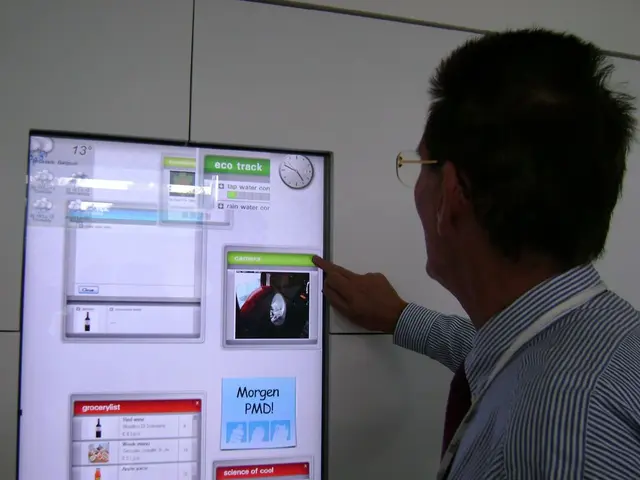Trade adjustment navigator aids exporters in adapting to trade fluctuations
In the ever-evolving landscape of international trade, understanding and navigating complex customs duties and regulations has become a critical challenge for businesses. To address this issue, KPMG, a leading global professional services network, has introduced the Tariff Modeller - a sophisticated tool designed to support businesses engaged in global trade.
The Tariff Modeller serves as a strategic map for businesses, offering a data-driven platform to model potential US tariff scenarios. This platform allows users to build hypothetical supply chain setups, compare import duties across sourcing alternatives, and evaluate cost-saving opportunities by shifting production or adjusting the origin of goods.
Powered by KPMG’s robust calculation engine and integrated with the KPMG Indirect Tax Toolkit, the Tariff Modeller can rapidly simulate thousands of transactions and test multiple tariff scenarios efficiently. This scalability and flexibility enable companies to quickly adapt to regulatory changes and assess potential financial impacts at speed.
Accurate and tailored tariff modeling is at the heart of the Tariff Modeller. By leveraging real, business-specific data rather than relying on generic one-size-fits-all calculators, the tool provides highly precise forecasts specific to a company's supply chains and operations.
The Tariff Modeller supports strategic supply chain and financial planning by enabling proactive analysis of tariffs. This allows businesses to integrate tariff considerations into pricing, transfer pricing, and overall supply chain decisions, helping mitigate risks such as margin erosion or unexpected cost increases arising from tariff changes.
The solution is designed for enterprise use, allowing organizations to apply it across different business units and jurisdictions for a comprehensive global trade tariff strategy. Moreover, the Tariff Modeller facilitates scenario testing and risk mitigation, enabling companies to prepare for various outcomes in global trade, turning tariff challenges into competitive advantages through informed decision-making.
KPMG offers hands-on support in implementing sourcing shifts or other tariff mitigation initiatives, ensuring strategic execution and long-term resilience. The firm helps businesses develop targeted cost-saving strategies aimed at mitigating tariff impacts based on the insights gathered from the Tariff Modeller.
The accuracy of the Tariff Modeller's analysis depends on the quality of input data provided by businesses, particularly the Bill of Materials (BOM) and detailed product composition. KPMG can support businesses by first assessing their current tariff exposure using the Tariff Modeller Analytics Tool.
The Tariff Modeller's Wildcard Modelling capability allows users to manually input tariff scenarios by HS code, country of origin, and manufacturing location. The tool also includes built-in logic to simulate how tariffs apply based on product composition, especially under policies like Section 232 that target metals.
The Tariff Modeller supports trade and customs planning by simulating the impact of various US tariff regimes on specific HS codes, product groups, and countries of origin. It also offers a pivot table and report creation feature, allowing users to export customized reports with selected data fields, offering insights tailored to their specific needs.
The majority of Vietnamese businesses expect intra-ASEAN trade to grow following the announcement of US tariffs. Vietnam is actively working with the United States on the early recognition of its market economy status to help Vietnamese goods shun market risks.
Recently, KPMG hosted a Tariff Modeller Demo Workshop on August 6, showcasing the tool's capabilities and benefits. In one illustrative scenario, businesses currently sourcing from China could reduce total import duties by nearly 65% by shifting production to Vietnam.
UOB revised up its forecast for Vietnam’s GDP growth in 2025 by 0.9 per cent due to promising trade negotiations with the United States in early July. This growth is a testament to the potential benefits businesses can reap from proactive tariff planning with tools like the Tariff Modeller.
In essence, KPMG’s Tariff Modeller helps businesses anticipate, quantify, and manage the financial and operational impacts of tariffs in global trade, making tariff planning a strategic rather than purely operational activity. This capability is increasingly important given the rising complexity of international trade regulations and tariffs' interaction with transfer pricing and supply chain management.
For long-term planning, the Tariff Modeller's usefulness is emphasized by Nguyen Nhat Linh, another director of Trade and Customs at KPMG. The tool's phased action plan feature helps prioritize high-impact areas for maximum efficiency, ensuring businesses can navigate the complexities of global trade with confidence and resilience.
The Tariff Modeller, a strategic tool provided by KPMG, allows businesses to model potential US tariff scenarios and evaluate cost-saving opportunities by adjusting the origin of goods, helping them integrate tariff considerations into pricing, transfer pricing, and overall supply chain decisions.
Powered by KPMG's robust calculation engine, the Tariff Modeller offers a data-driven platform for accurate and tailored tariff modeling, providing highly precise forecasts specific to a company's supply chains and operations.




